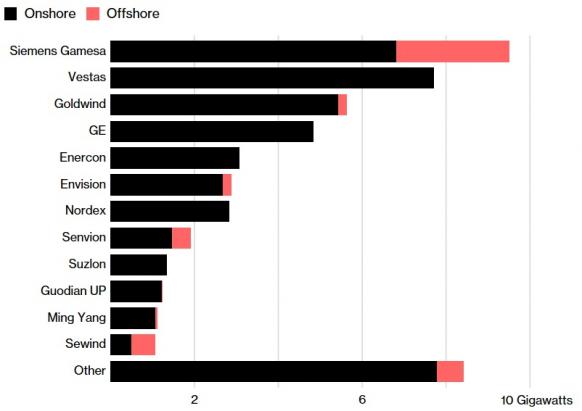Wind spares availability could hit 90% using aerospace learnings
Analytics and automation in the airline supply industry increased spares availability rates by more than half and cut inventory costs by 20%, Tushar Narsana, Managing Director, Supply Chain BPS at Accenture, told the Wind Operations Dallas 2018 conference.

Related Articles
Falling wind power prices have raised the importance of operations and maintenance costs (O&M) as owners look to maximize returns along the lifespan of the project.
O&M costs typically represent around 20% of the levelized cost of energy of a wind project and improvements in spare parts strategies is seen as a key way to reduce costs. According to some estimates, spare parts costs can represent up to 40% of O&M costs.
As wind operators increasingly turn to analytics to increase profitability, learnings from spare parts optimisation in the aerospace industry could be applied to wind projects.
The aircraft supply and wind power sectors both involve long-term assets with numerous components, complex international supply chain networks and continuing technology advances. In both industries, outages quickly impact revenues, increasing the importance of spare parts availability.
Projects to optimize aircraft spare parts strategies have shown that effective implementation of analytics and automation dramatically reduces asset downtimes while reducing parts inventories, Narsana told the conference on April 18.
A spare parts optimization project implemented for a major airline supplier increased spares availability rates to over 90%, a level which should be attainable by the wind sector, Narsana said.
"You should be able to hit the mid-90s in terms of availability... You may not start there, you may start in the 60s and the 70s...but systematically you should be able to get up there," he said.
The measures implemented by Accenture have had a major impact on aircraft availability, reducing aircraft on-ground time-- equivalent to unscheduled downtime-- by 35%, Narsana said.
Inventory mining
Between 2007 and 2017, Accenture performed a major spare parts optimization project for an international airline operator.
The aircraft operator required maintenance of an aircraft on the ground to be completed within 24 hours but faced the challenge of low spare parts availability, measured by "first order fill rate." In addition, around 40% of risks to maintenance performance were linked to quality and supplier issues and more than half of the delays resulted from short notice notifications.
The project aimed to increase the first order fill rate while reducing excess inventory and maintenance turnaround times.
A key first phase in the project was the optimization of inventory management.
Initial work concentrated on data cleansing to standardize terminology. Statistical analysis was then used to understand inventory needs, based on work orders and purchase order (PO) history and factoring in actual performance data.
Algorithms were then used to optimize the inventory using performance and historical data, which allowed the operator to forecast materials demand according to criticality, Narsana said.
"The key thing is planning- can I plan and forecast what I actually need before I go and buy it, " he said.
Key performance indicators (KPIs) were introduced and monitored to adjust stocking strategies, taking into account wider business goals.
A key challenge for inventory management is gaining the support from different divisions within the business, in particular between finance, operations and inventory management teams, Narsana said.
"A lot of people running and operating the asset don't care about the inventory, they just want as much inventory as they can hold," he said.
Supplier collaboration
Spare parts strategies require detailed supplier collaboration to ensure different suppliers are sharing the same desired outcome.
Top global turbine manufacturers in 2017
(Click image to enlarge)
Source: Bloomberg New Energy Finance (BNEF).
Operators should drive for improved visibility of the spare parts journey across the supply network, Narsana said.
"Get upstream in the manufacturing process... Put some kind of indicator on where they are in that step of the manufacturing process," he said.
Predictive modelling can then be used to understand lead times and provide operations teams with longer notification periods, Narsana said.
"Instead of getting a notification the night before, can you start predicting four, six, eight weeks in advance, so that you have a lot more time to react," he said.
Automation savings
To optimize the high volumes of purchase orders in the wind industry, operators should look to automate purchase order process using tools such as mini bots, to increase efficiency and reduce the impact of human errors, Narsana said.
"It saves some time, but more importantly it improves the accuracy dramatically," he said.
By converting purchase requisitions to POs using a mini bot, Accenture achieved a 100% quality rate for PO processing and reduced PO handling time by 80%.
By 2012, the aircraft spares project had increased the first order fill rate by 60% to consistently hit annual rates above 90%. Quarterly inventory costs fell by 20% and there was a 50% reduction in short notice supplier notifications, significantly reducing turn-around times.
The aerospace projects show how effective automation strategies can significantly improve the efficiency of spare parts management.
As computing power grows, this will open up new opportunities to reduce costs through automation, Narsana said.
"In today's world, you absolutely should be automating as much as you can,” he said.
New Energy Update

